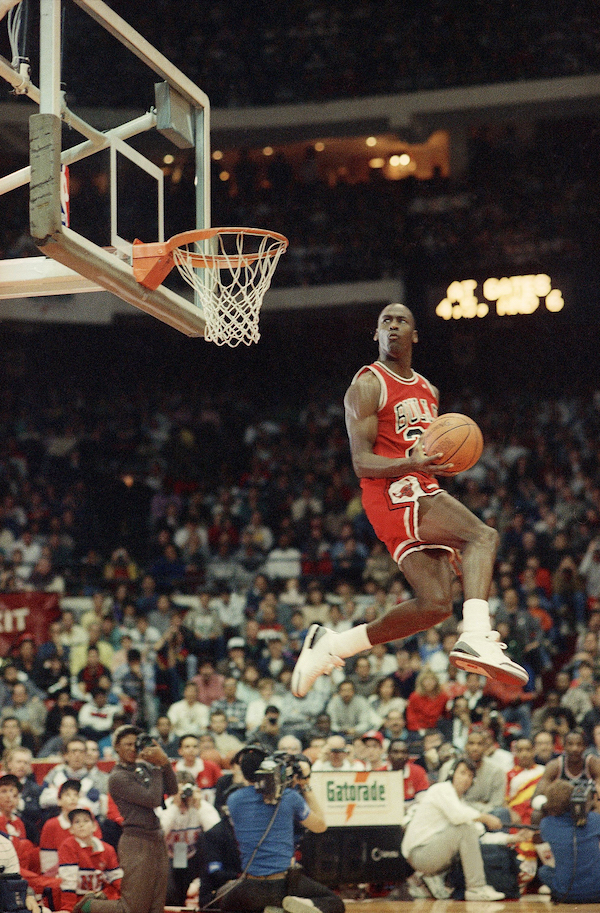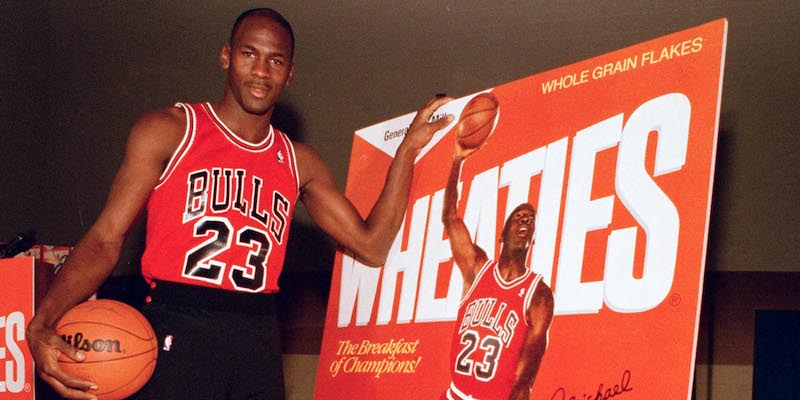Loading player
35 years ago on February 7, Chicago hosted the NBA All Star Weekend, the traditional weekend of events devoted to entertainment with which the American basketball championship celebrates its best players. Then, as now, one of the scheduled appointments, in addition to the “match of the stars” between the best players in the league, was the dunk contest. What happened that Saturday remained in the history of the championship and of world basketball: a young Michael Jordan, then 24 years old and at the beginning of his incredible career, made a memorable dunk, taking his feet off the free throw line, several meters before the basket .
That evening, that dunk and the photos that testified to it (ended up on posters, T-shirts and in various advertising campaigns) contributed to making Jordan also the protagonist of a successful marketing: Jordan was in fact one of the first sports stars to become a brand himself, with “Air Jordan” shoes. In the logo, contrary to what many think, another dunk is reproduced, made a few years earlier by Jordan for a photo shoot. Nike’s popular line of clothing and footwear designed for basketball players still bills the company $2 billion a year.
With that dunk Jordan got the highest marks from the jury, won for the second time in a row the contest among the best dunkers and exulted his audience, the fans of the Chicago Bulls, who followed the All Star Weekend at home. That evening and those photos earned him the nickname of “man who can fly”, as television commentators, fans and slogans of the commercials that saw him as the protagonist from then on said.
Jordan is universally recognized as one of the best players in basketball history and considered by many to be the best ever. In 1988, when that dunk contest was held in Chicago, he was in his fourth year as a pro. Since joining the NBA he had been one of his most followed players. In 1987 he had won his first title of best scorer, in 1988 he was awarded for the first time as best player, but he began to win with the Bulls only later, in 1991. In his career he reached the NBA Finals six times, winning six titles.
His athletic skills and the aesthetic grace with which he used them made him particularly beautiful and spectacular to see, as well as a natural candidate for the Slam Dunk Contest, one of the most popular events in those years, since the birth of the ‘All Star Weekend in 1984. At the time, it was common for the best players in the league to attend, but today the event is followed with less interest, also because it is increasingly difficult to find ways to surprise the crowd with a dunk.
That of 1988 is remembered as one of the most beautiful matches ever: in the various rounds of the competition the players, and in particular the two finalists, showed dunks of great level, difficulty and spectacularity. Of the initial seven entrants, Otis Smith (Golden State) and Clyde Drexler (Portland), another of the best players of that era, made it to the semifinals. Dominique arrived in the final together with Jordan Wilkins of the Atlanta Hawks, who had beaten him in the same competition in 1985 and who was one of the most athletic and spectacular players in the league: his nickname was an unequivocal The Human Highlight Film, translatable as “Human generator of great deeds”.
Dominique Wilkins in 2015 under her statue in Atlanta. (AP Photo/John Bazemore)
In the first two rounds available, Jordan and Wilkins put on a show. Wilkins took full marks from the jury twice (50), Jordan took a 50 and a 47. On Wilkins’ third and final dunk, the jury gave only 45, a rather low score, which however left Jordan and the home crowd the possibility of a comeback.
Jordan then ran up from the baseline, making it immediately clear what he wanted to do: he broke away from the free throw line but missed the dunk. On the second attempt (for each round they had three in two and a half minutes), he broke away a few centimeters beyond the line, arched in flight and crushed, taking a 50. He confirmed himself as champion after the 1987 victory even if, tell the players of the NBA era«even today if you meet Wilkins he will tell you how they stole that race from him».
The dunk performed by detaching from the free throw line was not a surprise for the Chicago public and for television viewers: Jordan had already proposed it in the two previous editions of the game in which he had participated, that of 1985 and 1987. He had “closed” (as they say in basketball jargon to indicate that he was able to complete them successfully) both times, but in a slightly less spectacular way.
The athletic gesture was nonetheless remarkable: if seen on television, or on YouTube, it may seem like a “doable” jump after all, but the free throw line is 4.57 meters from the basket, which is 3.05 meters from the ground. A walk on a regulation basketball court gives a better idea of how far the hoop is from the point of departure.

Michael Jordan during the dunk contest in Chicago in 1988 (AP Photo/John Swart)
Breaking away from there has always been a goal for the more athletic players: Jordan began to offer that dunk at the All Star Games as a tribute to those of Julius Erving, known as Doctor Jplayer of the seventies in many ways forerunner of the athletic and spectacular direction that the NBA would take in the following decades.
It’s not clear when NBA players began dunking from the free throw line (or trying to do so). According to some chronicles Wilt Chamberlain, who had enormous physical and athletic means, in the early years of his career (the 1960s) could achieve it “with great ease”, so much so that he evaluated the option of shooting free throws in this way. At the time, in fact, there was no rule in force today according to which after having released the ball during the “free throw” gesture, one could not cross the same line with one’s feet.
Second some chronicles, it was precisely to avoid this that first the university championship and then the NBA changed the rules, introducing a ban on landing over the line after shooting free throws: the two leagues never confirmed, even if the changes to the regulation came precisely in that period. In more recent years the dunk from the free throw line has been revived by many playerseven during a normal league game (among others, also from LeBron James) and also with some evolutions. During the 2016 All Star Game dunk contest, then-Minnesota Timberwolves player Zach LaVine complemented it by adding a mid-leg pass in mid-flight (LaVine actually deadlifted ahead of Jordan).
– Read also: Who brought Michael Jordan to Nike?
